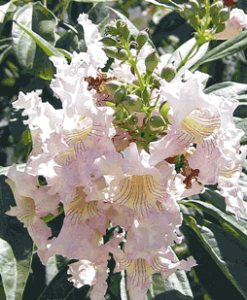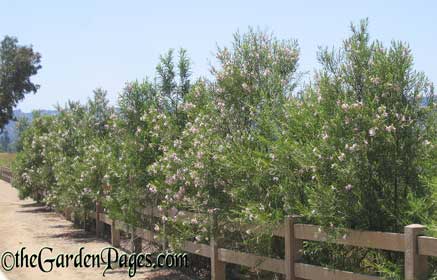Yes, it’s going to be 90 today, but my Favorite Time of the Year is just around the corner! It’s almost time for Fall Planting Season. This is your chance to decide what your personal landscape will look like next year – and how much money you are willing to give to the DWP each month. So you better get out your list and start checking it twice!

The Supulveda Dam Recreation Area covers acres of the San Fernando Valley. It’s main purpose is to serve as a catch basin for the Los Angeles river during floods. Much of the area has been developed into parks, there’s even a golf course in there and Balboa Lake, at the northern edge, is most famous for the blooming pink cherry trees who dance across the green rolling lawns in the spring. But there is also a large Wildlife Preserve and other areas planted in California or Western native plants.
Desert willow is one of the plants growing on the ‘wild side’ of the park. I caught these flowers as they were at the height of their bloom a few months ago. I would say they rival the fabled pink cherry blossoms and make a great alternative for dry gardens anywhere in the western US.
The exotic flowers are about three inches long and an inch wide and drip in giant clusters. Colors range from white or pastel pink to hot pinks or deep purple. Hummingbirds love the flowers and birds like the seeds too. Like cherry trees, they are deciduous, but Desert Willow develop exotic seed pods with cottony down before giving up for the winter. They can be left as large shrubs, or trained into multi-trunked trees. I’ve seen a few trained as regular standards too, but the trunks seem a little on the thin side to me. Of course, I’m partial to letting things go completely wild in the Back 40.
Unlike a cherry tree, they require little to no water once they are established; only 10 inches according to the USDA. Desert Willow can grow up to 30 feet tall and up to 20 feet wide and are hardy to 3 degrees. Their shiny leaves are thin and up to 5 inches long, with the traditional willow look. The shrubs are pretty even when they are not in bloom.
Put these on your list for fall planting season. I’ve found them at one of my favorite native nurseries; Las Pilitas Nursery
After the first year they should be living mainly on rainfall alone so you won’t have to sweat the 200% increase in water rates!

I didn’t know about Desert Willow, thanks for introducing me. Wow. The flowers look like super-prinked azaleas.
Did you mention what zone they are hardy to?
P.S. Las Pilitas is an amazing resource.